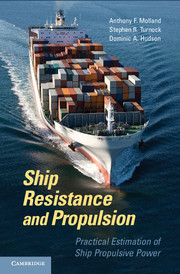Book contents
- Frontmatter
- Contents
- Preface
- Nomenclature
- Abbreviations
- Figure Acknowledgements
- 1 Introduction
- 2 Propulsive Power
- 3 Components of Hull Resistance
- 4 Model-Ship Extrapolation
- 5 Model-Ship Correlation
- 6 Restricted Water Depth and Breadth
- 7 Measurement of Resistance Components
- 8 Wake and Thrust Deduction
- 9 Numerical Estimation of Ship Resistance
- 10 Resistance Design Data
- 11 Propulsor Types
- 12 Propeller Characteristics
- 13 Powering Process
- 14 Hull Form Design
- 15 Numerical Methods for Propeller Analysis
- 16 Propulsor Design Data
- 17 Applications
- Appendix A1 Background Physics
- Appendix A2 Derivation of Eggers Formula for Wave Resistance
- Appendix A3 Tabulations of Resistance Design Data
- Appendix A4 Tabulations of Propulsor Design Data
- Index
Preface
Published online by Cambridge University Press: 07 September 2011
- Frontmatter
- Contents
- Preface
- Nomenclature
- Abbreviations
- Figure Acknowledgements
- 1 Introduction
- 2 Propulsive Power
- 3 Components of Hull Resistance
- 4 Model-Ship Extrapolation
- 5 Model-Ship Correlation
- 6 Restricted Water Depth and Breadth
- 7 Measurement of Resistance Components
- 8 Wake and Thrust Deduction
- 9 Numerical Estimation of Ship Resistance
- 10 Resistance Design Data
- 11 Propulsor Types
- 12 Propeller Characteristics
- 13 Powering Process
- 14 Hull Form Design
- 15 Numerical Methods for Propeller Analysis
- 16 Propulsor Design Data
- 17 Applications
- Appendix A1 Background Physics
- Appendix A2 Derivation of Eggers Formula for Wave Resistance
- Appendix A3 Tabulations of Resistance Design Data
- Appendix A4 Tabulations of Propulsor Design Data
- Index
Summary
New ship types and applications continue to be developed in response to economic, societal and technical factors, including changes in operational speeds and fluctuations in fuel costs. These changes in ship design all depend on reliable estimates of ship propulsive power. There is a growing need to minimise power, fuel consumption and operating costs driven by environmental concerns and from an economic perspective. The International Maritime Organisation (IMO) is leading the shipping sector in efforts to reduce emissions such as NOx, SOx and CO2 through the development of legislation and operational guidelines.
The estimation of ship propulsive power is fundamental to the process of designing and operating a ship. Knowledge of the propulsive power enables the size and mass of the propulsion engines to be established and estimates made of the fuel consumption and likely operating costs. The methods whereby ship resistance and propulsion are evaluated will never be an exact science, but require a combination of analysis, experiments, computations and empiricism. This book provides an up-to-date detailed appraisal of the data sources, methods and techniques for establishing propulsive power.
- Type
- Chapter
- Information
- Ship Resistance and PropulsionPractical Estimation of Propulsive Power, pp. xv - xviPublisher: Cambridge University PressPrint publication year: 2011
- 2
- Cited by

